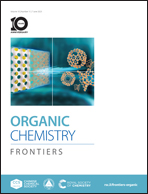Hydroxylation of organoborons via uranyl photocatalysis†
Abstract
Aerobic oxidation of organoboron, via uranyl photocatalysis using the principle of indirect single electron transfer (i-SET), was established under mild ambient conditions, and afforded multifarious phenols and alcohols, including nine natural products/pharmaceuticals. The i-SET process between the uranyl catalyst and triethylamine (Et3N), rather than through direct oxygen molecules (O2), was determined through UV–visible absorption experiments, Stern–Volmer analysis, and density functional theory calculations. 18O labeling experiments showed unambiguously that the oxygen was derived from O2. The hundred-fold efficiency of a flow operation further demonstrated the potential for scaling up the application.

- This article is part of the themed collection: FOCUS: Frontiers in Boron Chemistry


 Please wait while we load your content...
Please wait while we load your content...